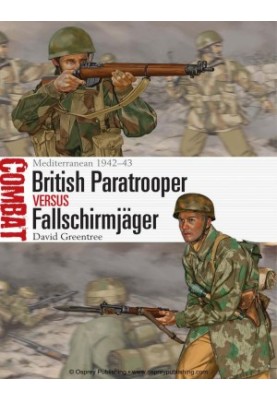British Paratrooper vs Fallschirmjäger: Mediterranean 1942–43 (Combat)
 Instant download
Instant download
after payment (24/7)
 Wide range of formats
Wide range of formats
(for all gadgets)
 Full book
Full book
(including for Apple and Android)
By late 1942 Britain had developed an airborne capability that would obtain its baptism of fire versus German airborne in North Africa and Sicily. On three notable occasions British airborne infantry fought intense battles with its German counterpart: twice in North Africa and again at Primosole Bridge in Sicily. Both forces were well trained and equipped, with a similar ethos and role, both thought of themselves as elite units, and both found themselves used by local commanders in a variety of roles that tended to be determined by the emergencies of the moment. On 29 November 1942 Lt Col Frost's 2nd Para dropped at Depienne, Tunisia, with orders to march overnight to Oudna, destroy the aircraft there and then return to Allied lines. Finding no aircraft they retreated, repeatedly combating elements of Oberst Koch's FJR 5, deployed in a ground role. 2nd Para ambushed and drove back Fallschirmjäger riding on armoured cars. Nearly surrounded, Frost withdrew to a nearby hill; a battle ensued as both sides raced for the crest. After retreating overnight 2nd Para wiped out an attacking German platoon, and on 3 December Frost's men finally reached Allied lines; all told, they had made five night marches and fought three battles, in total covering 50 miles, and only 180 of Frost's 450 men remained effective. Fighting as infantry, elements of 3rd Para encountered two companies of Fallschirmjäger-Pionier Bataillon, supported by elements of armour and artillery, in a strongly fortified position at Djebel Azag. On the night of 4/5 January 1943 a see-saw battle took place as the hill changed hands. The Germans were able to retain this key position. After weeks of further bitter fighting the British parachute brigade was again pulled out of the line in March 1943, but there would be no respite for any of the German parachute units; in May nearly all of those who had survived became POWs. On the night of 13/14 July 1943, 1st Para Brigade dropped to seize the Primosole Bridge in Sicily and hold it until relieved the next day by 50th Division. Unknown to Allied planners, though, Fallschirmjager dropped nearby in the last large-scale German airdrop of WWII. The Allied airborne was badly dispersed by AA fire. However, the British successfully seized the bridge and held it until an improvised counter-attack retook it. Midway through the evening of 14 July elements of 50th Division succeeded in relieving the Paras, retaking the bridge after 2 more days of bitter fighting. The Germans withdrew after failing to destroy the bridge with a truck-borne improvised explosive device. The battle at Primosole Bridge had immediate strategic consequences for both sides: for Britain an inquiry was held as to whether airborne forces were worth the investment, while for Germany the engagement proved the concept that elite infantry capable of being transported quickly by air to hotspots in the line could avert disaster. Featuring vivid first-hand accounts, specially commissioned full-colour artwork and in-depth analysis, this is the gripping story of the clash between airborne forces at the height of WWII.
LF/619963032/R
Data sheet
- Name of the Author
- David
Greentree - Language
- English
- Series
- Osprey Combat
- ISBN
- 9781780969244
- Release date
- 2013
- Volume
- 1

























